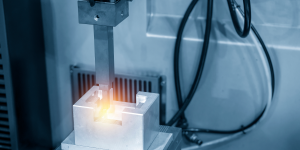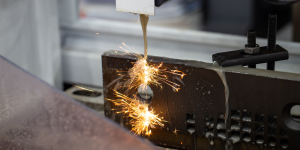The precision and adaptability of electrical discharge machining (EDM) make today’s manufacturing business. This process involves the ejection of material from a workpiece through electrical discharge in order to produce complex designs and shapes. We will discuss seven ways to use EDM and provide you with the best tips on how to make full use of this contemporary technology.
1. What is electrical discharge machining (EDM) and how does it work?
Electric sparks grind material from a workpiece in electrical discharge machining is an accurate manufacturing procedure. It is applied in aerospace, automotive, and medical industries to produce complex forms. In the process, the workpiece and tool or electrode are electrodes. The two electrodes create a controlled arc that erodes the workpiece.
Also, heat from electrode sparks melts and vaporizes material dielectric fluid flushes away. In spite of the fact that hardened steel and strange alloys are tough to mill, EDM works well. its strengths are high precision, good surface quality and complicated shapes with tight tolerances. Many sectors depend on EDM, a versatile and efficient production process.
2. How can EDM be used for creating complex shapes?
Electrical Discharge Machining (EDM) can precisely and accurately manufacture complex forms. EDM uses electrical sparks to dissolve the material and create detailed shapes that regular machining cannot. A dielectric fluid controls spark generation and a copper or graphite electrode is used.

Sparks between the electrode and the workpiece form tiny craters that erode and shape the material. Aerospace, automotive, and medical device industries can use this approach to make complicated shapes. EDM works on hardened steels, titanium, and exotic alloys. EDM allows complicated shapes in design and manufacturing, pushing engineering limits.
3. What are the advantages of using EDM for tool and die-making?
Electrical Discharge Machining (EDM) for tool and die manufacture has many benefits. First and foremost, EDM can create detailed and sophisticated shapes that regular machining cannot. Because EDM employs electrical sparks to degrade the material, it makes precise incisions. EDM can work with hardened steels and exotic alloys, another benefit.
EDM cuts without touching the workpiece, lowering the possibility of distortion or damage. EDM can precisely generate small, delicate features like sharp corners or subtle details. EDM produces reliable outcomes and reduces manual adjustments and rework because it is repeatable. EDM is useful for tool and die production because of its many benefits.
4. How can EDM be utilized for the production of prototypes?
EDM (Electronic Dance Music) concepts must be understood to use this genre to create prototypes. EDM includes house, techno, and dubstep and is always developing. Music fans worldwide love its catchy beats and intricate melodies. EDM’s potential goes beyond entertainment. It can boost prototyping.
EDM’s rhythmic components and auditory textures allow designers and engineers to create functional prototypes that engage users sensoryly. The throbbing basslines and ecstatic synthesizer melodies can encourage creativity and challenge design norms. EDM’s energy and complexity can be transferred into physical prototypes that are startling and innovative. Next time you prototype, consider how EDM can spark invention.
5. What role does EDM play in the aerospace industry?
EDM, or Electrical Discharge Machining, is vital to aerospace. This innovative machining method uses electrical sparks to degrade material for accurate cuts. EDM is widely used in aerospace to make complex components and molds for aircraft engines and structures. This technology lets producers accurately and repeatably make complicated shapes and designs.

EDM is useful in aerospace because it can process titanium and nickel alloys. Aerospace businesses may make lightweight, robust components, improving fuel efficiency and aircraft performance. EDM also extends the lifespan of important aircraft parts through repair and maintenance. In conclusion, EDM helps the aerospace industry create complex components, improve performance, and ensure aircraft safety and reliability.
6. How can EDM be utilized in the medical field?
Electronic Dance Music (EDM) goes beyond parties and entertainment. It is a potent therapeutic and treatment tool in medicine. EDM reduces tension and anxiety in patients by stimulating the brain and relaxing with its throbbing beats and rhythmic patterns.
EDM is also used in virtual reality systems, allowing patients to experience treatment in a virtual world. This novel strategy improves therapy efficacy and patient engagement. EDM is a promising medical research avenue due to its adaptability and potential advantages.
7. What are the applications of EDM in the electronics industry?
The electronics industry uses electrical discharge machining (EDM), a versatile production technology. Its many uses make it essential for electronic components. EDM is used to make complicated electronic device molds. EDM’s precision and accuracy enable complicated mold surface patterns and designs, ensuring electronic component functionality.
EDM also makes microelectrodes for integrated circuits and microchips. EDM is ideal for miniaturizing electrical components due to its precision. Additionally, EDM is used to make connections, sensors, and other important electronic elements. EDM has several uses in the electronics sector and helps make high-quality gadgets.
Conclusion
Electrical discharge machining is a wonderful technique with incredible industrial applications. EDM offers precision and versatility that traditional machining technologies cannot match when creating complicated geometries, prototypes, or crucial components. Manufacturing can reach new heights of creativity and production with EDM. So why delay? Enter EDM and discover its unlimited potential!
